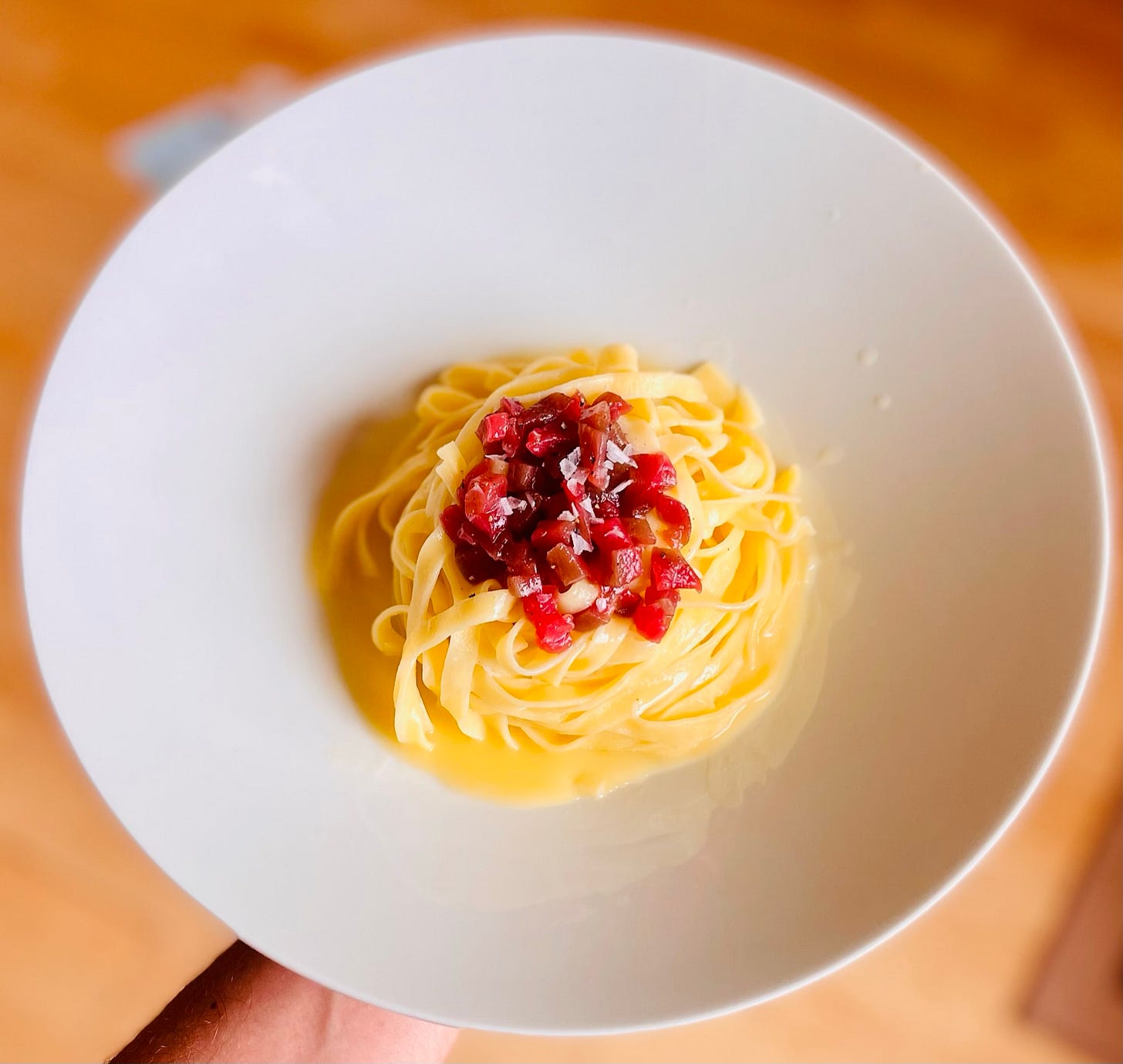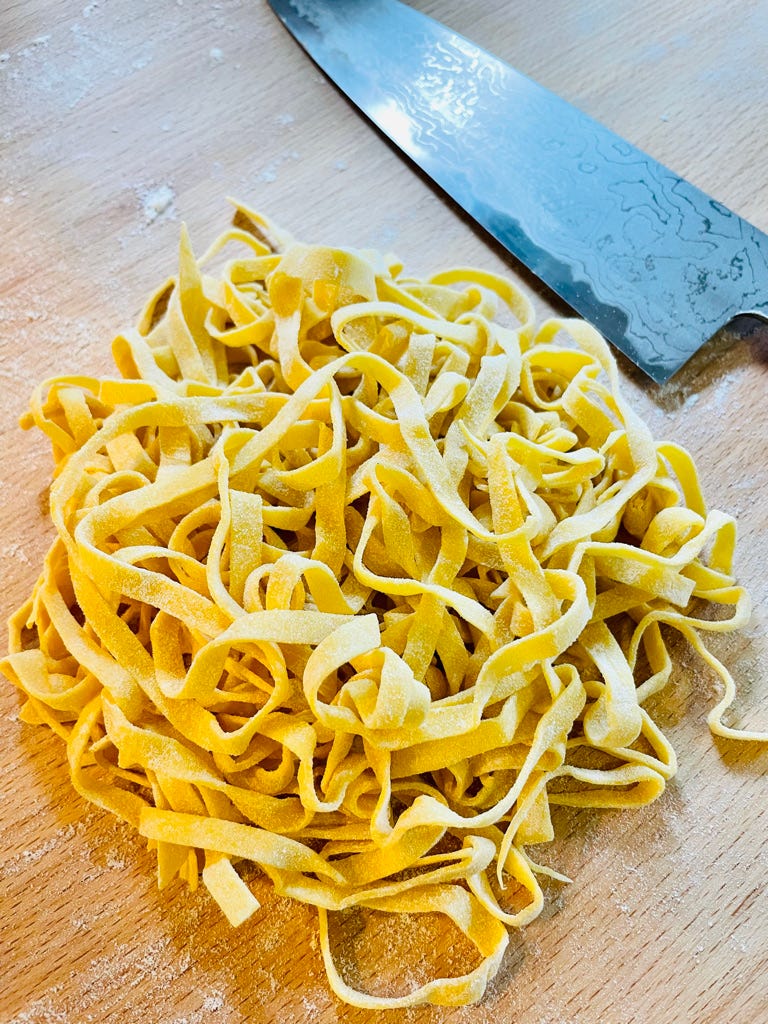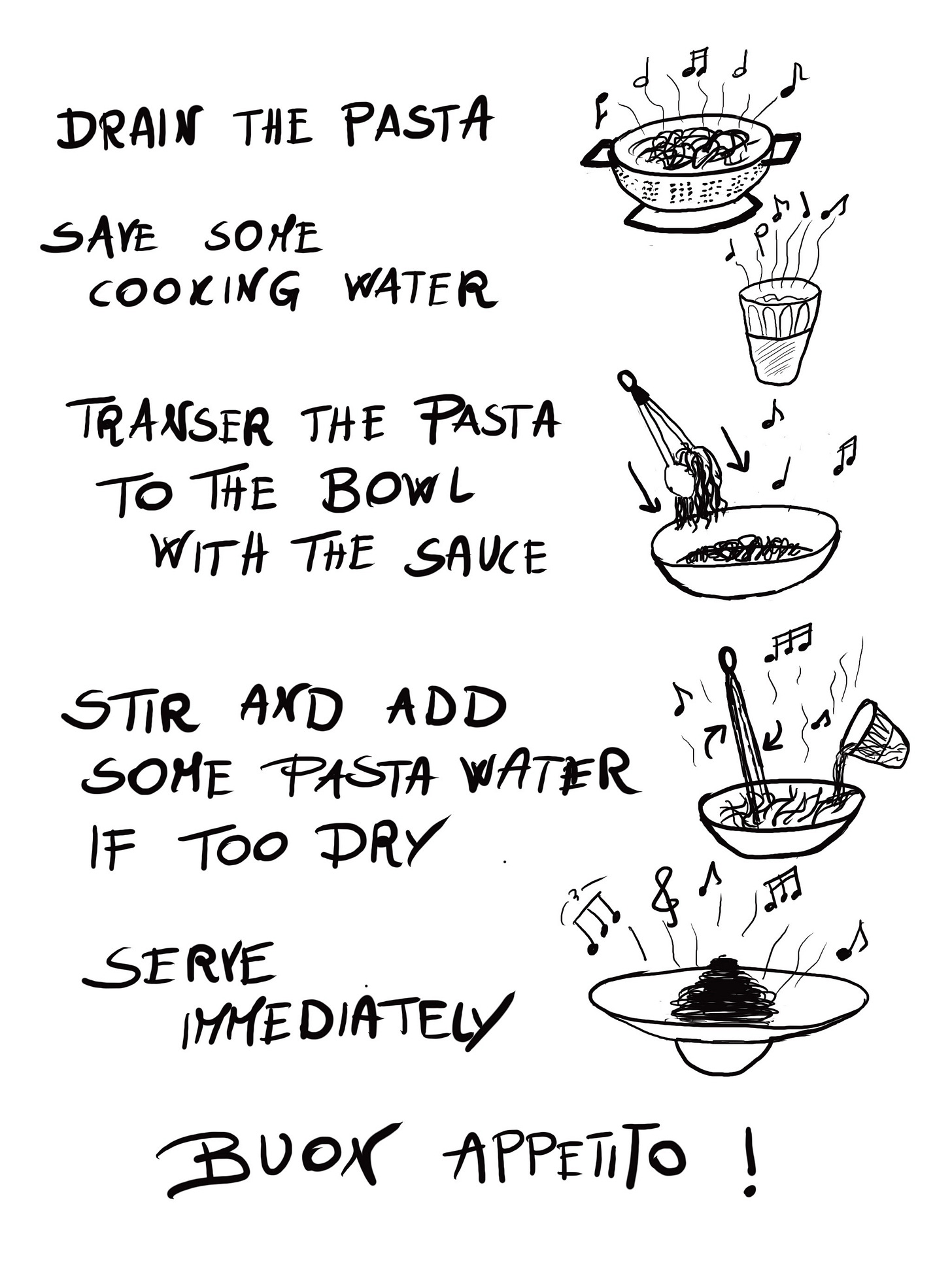Pasta is the food that most people all over the world identify with Italy.
It’s a blank canvas with virtually unlimited options. It’s cheap, easy and quick to make, and it will keep you full for hours.
Yet, when non Italian friends come over for dinner they often comment: “I wish I could make my pasta taste like yours”, or “why does your pasta taste so much better?”
Cooking pasta is easy but it’s not simple!
Messing it up is equally easy and you wouldn’t believe how many times I’ve seen this most basic process ruined in a quite dramatic way.
For this reason I made a semi-serious post on my socials (a while back) with a set of rules on the way I do not cook pasta. The post generated a lot of debate and hilarity so I thought I would add it here again, improved and expanded with a set of drawings that get more into the details on how I actually do cook pasta.
Before that, let me elaborate for a minute on culinary rules:
Italians have many rules for everything, and when it comes to food, these rules often turn into undebatable dogma. How many of you have experienced the classic “mistake” of asking for parmigiano with your seafood pasta, or ordering your cappuccino after dinner or (God forbid) with your dinner?
Many of these rules seem abstract to foreigners and they annoy tourists as much as the breaking of them annoy Italians.
I personally have very mixed feelings about rules in general, but I am completely allergic to dogma for dogma’s sake. It is one of my least favourite aspects of Italian culture, so these days I always try to question food rules, investigate their origins, and then evaluate for myself whether I think they are worth of being respected.
Many of the Italian food rules have a quite rational reasoning behind and if not, at least a cultural specific reason, a history and years of traditions that always start from respect for the quality of the ingredients. On the other hand some of the rules are based entirely on habit and stubbornness.
I also want to open a small parenthesis mentioning once again that Italian food culture is oral food culture, so in constant motion and development by definition. There is not one way to make a dish in Italian food culture. If someone tells you otherwise, there is usually another reason behind it. Freezing oral culture (same as for music) means “academising” it, and eventually killing its vitality while trying to achieve the opposite.
So here comes the personal and highly debatable list of non rules. By listing the things that I would never do when cooking a plate of pasta, I try to highlight what I see as the most common problems I encountered during my time spent away from Italy.
When cooking pasta I will never:
Let cooked pasta sit in a pot by itself.
“Vade retro Satana!”, sin of all sins!!
Cooked pasta dries out very quickly when it’s not “dressed”, and it turns into glue in matter of seconds.Bring the above mentioned gluey pasta pot to the table and the sauce in two separate pots, and just put them together on the plate.
For the same reasons as above but also because pasta and sauce do not mix properly on a plate (see drawing below). If you really need to do that, please at least mix the sauce into the above pasta pot and bring it to the table already mixed.
Buy poor quality pasta, poor quality tinned tomatoes and poor quality EVOO
Use “parmesan” that comes out of a box on a shelf of the supermarket (that’s actually sawdust!)
Italian food is really easy to make, but it thrives on the quality of a few basic ingredients. In other words if you use three ingredients for a dish and they are poor quality, there is nowhere to hide, no “seasoning” is gonna save it, it’s gonna taste bad…no way around it I’m afraid.
Empty the contents of the fridge on a plate of pasta. You really only need a few things…and a reason…
Have you ever noticed how traditional Italian recipes usually have a maximum of 3-4 ingredients and flavour combinations? It’s very rarely more than that, and once again, it’s about the quality of the ingredients and how they interact in a clean linear way. The easiest way to recognise a “fake” Italian restaurant is by looking at how many ingredients they have in their pasta and pizza dishes (aside from spelling errors 😅).
Cook the pasta before the guests arrive
Eat pasta gone cold
Italians hate eating pasta gone cold, and the turnaround is very quick. You can pick out Italian children on how quick they are to come to the table when you announce “it’s ready!”. They have been trained!
For the same reason if you are waiting for guests, you do not add the pasta to the boiling water until they are inside your home. That changes if they called saying “butta la pasta”. This phrase means “throw the pasta in” and it’s a classic phone call Italians make when they are about 5 minutes away from the house.Use random pasta formats with whatever sauce
This is a tricky one to explain cause it’s probably connected to habit, I think every Italian develops and instinct for their favourite combinations. There are also practical reasons why certain sauces will call for certain formats, but it’s too long of a subject to address here and I will come back to it with a future post.
Cook or warm up pesto
This one I see a lot all over the world. Pesto is a sauce that doesn’t stand much heating up before it changes flavour and becomes bitter. So adding a small spoonful of warm pasta cooking water is ok, but if you warm it up in a pan, it will be spoiled.
(Also…basil pesto is delicious but why is it added to every possible Italian food abroad? “Oh it’s italian food so it’s gotta have pesto in it”…makes no sense to me…but it’s a rant for another day).Not taste the pasta to check how cooked it is before i drain it
I always recommend using a timer, just as a reference, so you roughly know how much time you have left while making the sauce, or other dishes. Always taste it a few times as the timer approaches the end of cooking time, and remember that the pasta brand and the size of your pot will influence the cooking time.
I also always weigh my pasta, as warmed up leftover pasta doesn’t work for me (It always gets overcooked).Use pasta as a side dish
Eat pasta and salad on the same plate
Italians don’t like many things on a plate, mostly because they like clean flavours, so the idea of your tomato sauce invading your salad’s personal space horrifies most of us.
Add oil to the boiling pot.
This is something I never saw in Italy. I am not sure who started it, but it’s been scientifically proven many times that oil doesn’t help spaghetti from sticking to each other. It floats on the surface and if anything it makes the pasta oily and it’s harder to mix it with the sauce.
You really only need to stir the pasta a few times within the first minutes and it will not stick. Never forget about your pasta cooking in the pot, she will know it and feel neglected…and stick…
Now that we are clear about what not to do, let’s look at this little drawing I made
The question of hot or cold sauce is a vital one as it will influence what comes next.
For a warm sauce (like a classic tomato sauce or a ragù), we want to finish cooking the pasta together with the sauce. For this process we use a bit of the pasta cooking water, which is full of starch as binding element, and this will help the sauce and the pasta stick to each other. If you are able to do a quick pan toss, this will further help to distribute the sauce evenly and to incorporate some air into it, making the sauce glossy and more “creamy”
Proceed as described here:
When your pasta sauce is cold (like a classic basil pesto for example), you proceed in a similar way but away from the heat source. Be careful with adding pasta water as if you add too much your sauce will turn too liquid, and you can’t really do anything about it (with the hot sauce you can keep tossing on the heat until it reaches the right consistency). So proceed with tiny amounts at a time.
There are more pasta cooking techniques these days, like the more extreme “risotto” technique, where the pasta is cooked from the start in its sauce, but maybe I will get into those in another instalment, as I don’t want to confuse ideas further here.
Let me know if you have any questions, and if you would like to see videos of these two techniques.








The line drawing flow chart is phenomenal! Grazie mille!
Thanks Francesco! We might benefit from a treatise on "al dente" sometime you have the urge to take on this big topic :-)